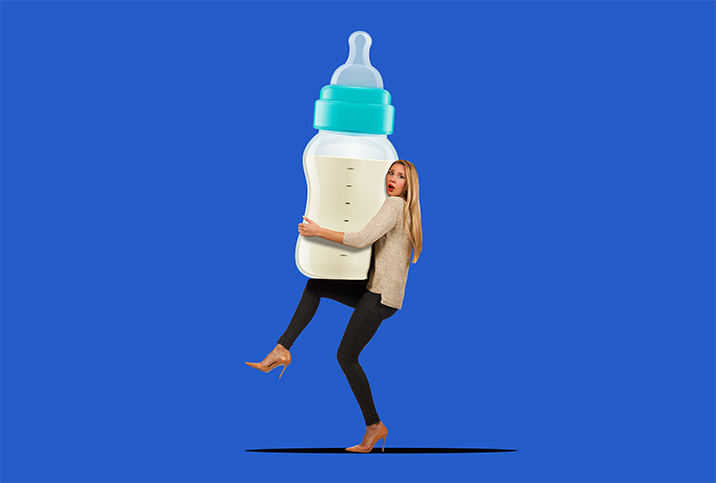Bottle and Breast: Your Combination Feeding Survival Guide

Combination feeding, referred to as combi feeding, supplements breastfeeding your baby with formula. While the method is not talked about as often as full breast- or formula feeding, it can be useful for parents encountering challenges to breastfeeding.
There can be many reasons why parents may want to feed this way, including being "touched out," illness in the mother or baby, low milk supply, needing to work or an inability to express enough milk.
I combi fed my baby because he couldn't latch. It helped him to feed until he had his tongue tie cut and my breasts became a better shape for feeding as they were too engorged after birth. I also pumped, but breastfeeding directly was much more enjoyable once I was able to do it.
While some parents may feel like they have to choose either exclusively breastfeeding or formula milk feeding, that doesn't have to be the case. It's also possible to transition from one to the other.
Why combination feeding may help
"There are countless cases when introducing formula is a great decision and part of a healthy journey to establishing breastfeeding," said Rebekah Diamond, M.D., assistant professor of pediatrics at Columbia University in New York City and author of "Parent Like a Pediatrician." She outlined that even if there are reasons for supplementing breastfeeding in the first weeks or months of a baby's life, it doesn't mean breastfeeding isn't the goal. It can also make sense to support a parent's personal needs, including depression, anxiety or exhaustion.
Diamond stressed the importance of using an International Board Certified Lactation Consultant (IBCLC) to help you reach your breastfeeding goals.
"The biology of the infant-suck/maternal milk production feedback loop is important to understand, because strategies that maximize nursing overall and minimize bottles and pumping tend to lead to sustained breastfeeding," she explained.
Jessica Madden, M.D., a Cleveland-based certified lactation consultant, board-certified pediatrician, neonatologist and medical director at Aeroflow Breastpumps, highlighted the situations that combi feeding can help:
- Low milk supply
- Jaundice
- Prematurity
- Feeding multiples (twins or triplets)
- Postpartum depression
- Slow weight gain in baby
- Maternity leave is too short (or no maternity leave at all)
- Inadequate breastfeeding support for problems including pain, plugged milk ducts and mastitis
- Prolonged separation of mom and baby
Combi feeding can also help with dysphoric milk ejection reflex (D-MER), which is characterized by negative emotions at the time of milk letdown.
How to begin combi feeding
"If you'd like to continue to directly breastfeed as you combi feed, it's optimal to wait until breastfeeding is well-established, for example, at least three to four weeks, to introduce a bottle," Madden advised.
This can also mean using a breast pump if you are separated from your baby for any length of time. She recommended pumping after breastfeeding and then having another person give the bottle to the baby to avoid "triple feeding," which can be exhausting for the feeding parent.
Crystal King, the Orlando-based creator of the Amazing Baby app, combi fed both of her children. What worked for her was always breastfeeding first, making sure the latch was correct and using a slow-flow nipple on the bottles she used.
King advised asking for help whenever needed. She had an appointment with a lactation consultant every week from week one to eight after giving birth to her first baby.
"Throughout your feeding journey, always, always ask your lactation consultant for support if you experience any challenges," she said.
Important advice to keep in mind when combi feeding
"As long as the milk is continuously being removed, the breastfeeding parent will continue to make more milk," explained Caitlyn Parker, a Florida-based IBCLC and consultant relations manager at the Lactation Network.
Her recommendation is to have a structure of nursing times as well as bottle times so your baby knows what to expect.
If a parent moves from breastfeeding to combi feeding, Parker explained that there can be a "big hormonal shift," which can cause feelings of sadness, tearfulness and excitement. While this is common, speak with your healthcare provider if these symptoms last longer than a couple of weeks.
Another issue is the risk of mastitis, an inflammation of breast tissue, is higher with combi feeding because the breasts aren't being emptied as regularly, explained Caitlin Goodwin, M.S.N., R.N., a board-certified nurse midwife in West Palm Beach, Florida, and medical consultant at Mom Loves Best, a pregnancy and motherhood resource site.
'As with all aspects of parenting, it helps to have an open mind with combi feeding.'
Combi feeding may also increase the likelihood of breast refusal. To avoid confusion and decrease this risk, Goodwin recommended asking a separate person to do bottle-feeding, or if the baby is older than 6 months, they can drink from a cup. During breastfeeding, hold the baby against your chest to encourage skin-to-skin contact to stimulate them to feed.
"As with all aspects of parenting, it helps to have an open mind with combi feeding," Madden said. "Flexibility and patience are key, and it will get easier with time, I promise."
As a parent who is still combi feeding, I can confirm it does get easier. Feeding your baby is an ongoing journey and not one that has to be perfect. You and your baby will find your own way, and the experience can help bring you closer together at the same time.


















